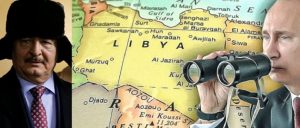The past half-decade has seen Russia re-enter the Middle East arena more forcefully than at any time since the collapse of the Soviet Union nearly 30 years ago. As it strives to reassert itself in a region where its influence was once second only to that of the United States, Moscow has used its largely successful military intervention in the Syrian civil war to bolster its status, signing new political and military deals with countries ranging from Egypt and Jordan to Iraq, Turkey and Iran, like reported by asiatimes.com.
This seemingly unstoppable rise and the prospect of Vladimir Putin’s Russia becoming a bona fide rival in the Middle East has caused alarm among US policymakers and analysts.
But by wading into one troubled state in the southern Mediterranean, Moscow could well have bitten off more than it can chew.
The past three months of Russian involvement in Libya suggest that the Kremlin is unable to tip the balance decisively there as it did in Syria – and worse, that Russian policymakers either don’t know it or don’t want to know.
Instead, they are escalating their involvement, thereby increasing the chances of considerable political and material losses with little prospect of achieving any breakthrough.
After injecting hundreds of mercenaries into the North African country last year in support of Libyan National Army (LNA) leader Khalifa Haftar, Russian personnel losses are mounting up. The investigative news outlet Meduza reported as many as 35 Russian fatal casualties by October 2019, both among the Wagner private military contract agency and freelance mercenaries.
No updated casualty counts have emerged since then, although with reports of Russian contract soldiers fighting in Tripoli at least through December, the number certainly would have gone up. The official confirmation this month of the death of the first regular-army soldier indicated both the extent of Moscow’s involvement in Libya and the intention to increase support for Haftar and the LNA.
This is bound to widen the rift between Russia and Turkey, Moscow’s erstwhile partner in Syria. Turkey has chosen to back the other side, the Government of National Accord (GNA), sending in military advisers and 2,000 Syrian fighters, with President Recep Tayyip Erdogan vowing to “teach Haftar a lesson” if the LNA leader resumes his advance on Tripoli.
The timing could not be worse. A Russian-backed offensive by the Syrian government has killed Turkish servicemen and created a new refugee crisis on Turkey’s border with Syria, prompting threats of unilateral military retaliation from Erdogan. The Moscow-Ankara alliance, which was crucial in consolidating Russian gains in Syria, is at breaking point.
The death in Libya of Gleb Mostovoi, a Russian regular-army soldier, raises a number of interesting possibilities. In Syria, Moscow deployed two main types of ground forces: military advisers for select pro-regime armed formations and special forces operating as light infantry, carrying out tasks such as reconnaissance and spotting for artillery and air strikes.
Since there is no indication that Mostovoi, who was buried in his native village near the Kazakhstan border on February 14, was a member of any special forces units, we must assume he was a “military adviser.” If Russia is indeed repeating its Syria strategy in Libya, Mostovoi’s death indicates it is not getting the same results. The next step could well be to send in special forces to boost Haftar’s troops in the hope of breaking the stalemate.
A less known component of Russia’s forces in Syria are the four battalions of North Caucasus military police. Numbering roughly 400-strong each and highly visible, they have proved remarkably effective at freezing frontlines (thus enabling manpower to be transferred elsewhere) and deterring other forces (such as the Turks) from launching military escapades. After all, no one wants to risk killing Russian servicemen so publicly.
Another possibility concerns Chechen servicemen. Chechnya’s leader Ramzan Kadyrov has repeatedly expressed his desire to send forces to combat “terrorism” in Syria, a request he has been denied so far. But with an increasingly active diplomatic role in Libya (via his envoy, Lev Dengov), Kadyrov may yet get his wish.
Chechnya also continues to offer training for Arab military units at its massive new “Special Forces University,” 36 kilometers from the capital, Grozny, so it is entirely plausible that Chechen commandos could end up on the Libyan battlefield next.
However, these possibilities are contingent upon the Kremlin making one major policy decision: Is Russia prepared to engage in highly destructive urban warfare for the sake of the Libyan capital?
Tripoli has so far proved a difficult target for Haftar’s forces. Months of failed offensives have demonstrated that even the addition of hundreds of Russian mercenary fighters are far from enough to take territory from the pro-GNA militias and hold it. In Syria, major gains came only after months of devastating Russian aerial bombardment on dense urban landscapes, most notably the rebel-held half of Aleppo city and the Eastern Ghouta suburbs of Damascus. Both areas were virtually annihilated, with mass flows of refugees and catastrophic destruction of infrastructure.
Despite years of continuous warfare, Tripoli has largely escaped this fate and it would seem unconscionable for Russia to be the one to pulverize the city. On the other hand, Moscow has faced few, if any, consequences for its actions elsewhere, so perhaps the notion of razing Tripoli to the ground is not so far-fetched.
As Russia steadily deepens its involvement in Libya and the voices of international condemnation remain faint, there is only one outcome for Libya: more carnage, more chaos, and more death.



